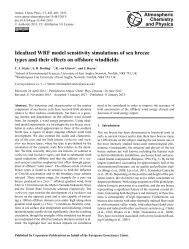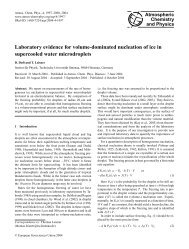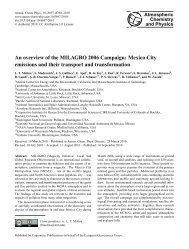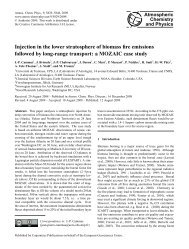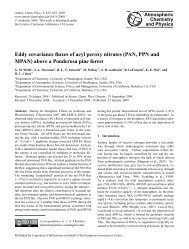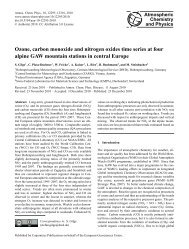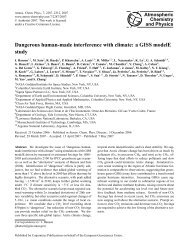A modified band approach for the accurate calculation of online ...
A modified band approach for the accurate calculation of online ...
A modified band approach for the accurate calculation of online ...
Create successful ePaper yourself
Turn your PDF publications into a flip-book with our unique Google optimized e-Paper software.
4142 J. E.Williams et al.: Online photolysis in Chemical Transport Models<br />
Table 3. Definitions <strong>of</strong> <strong>the</strong> tropospheric and stratospheric chemical subsets selected <strong>for</strong> <strong>the</strong> derivation <strong>of</strong> <strong>the</strong> low sun <strong>band</strong> settings and <strong>the</strong><br />
analysis <strong>of</strong> <strong>the</strong> per<strong>for</strong>mance <strong>of</strong> <strong>the</strong> <strong>modified</strong> <strong>band</strong> <strong>approach</strong>. The spectral range indicates <strong>the</strong> spectral region over which each species exhibits<br />
absorption.<br />
Troposphere Stratosphere<br />
Photolysis reaction Spectral range [nm] Photolysis reaction Spectral range [nm]<br />
O3 hv<br />
−→ O2 + O 1D 219.8–342.5 N2O hv<br />
−→N2 + O 1D 178.6–241.0<br />
NO2 hv<br />
−→ NO + O 3P 202.0–422.5 OClO hv<br />
−→ ClO + O 3P 259.7–477.5<br />
N2O5 hv<br />
−→ NO2 + NO3 178.6–382.5 Cl2O2 hv<br />
−→ Cl + ClO2<br />
HNO3 hv<br />
−→ OH + NO2 178.6–352.5 ClNO3 hv<br />
−→ Cl + NO3<br />
178.6–452.5<br />
196.1–422.5<br />
HNO4 hv<br />
−→ HO2 + NO2 178.6–327.9 BrNO3 hv<br />
−→ Br + NO3 178.6–497.5<br />
H2O2 hv<br />
−→ 2 OH 178.6–347.5 BrO hv<br />
−→ Br + O 3P 311.5–392.5<br />
CH2O hv<br />
−→ HCO + H 298.1–347.5 CCl2F2 hv<br />
−→Products 178.6–241.0<br />
CH2O hv<br />
−→ CO + H2 298.1–357.5 BrCl hv<br />
−→ Br + Cl 200.0-602.5<br />
The spherical radiative transfer equation, as given in<br />
Eq. (6), represents a differential equation <strong>for</strong> three spatial parameters.<br />
It can be solved by integration along a representative<br />
set <strong>of</strong> <strong>the</strong> characteristic lines. In turn <strong>the</strong> intensity field (I)<br />
can be determined using a Picard iteration scheme. However,<br />
<strong>for</strong> <strong>the</strong> three-dimensional spatial problem a large number <strong>of</strong><br />
characteristic lines are needed, which hampers any numerical<br />
implementation. Here Rozanov et al. (2001) and Doicu<br />
et al. (2005) have shown that <strong>the</strong> number <strong>of</strong> characteristic<br />
lines can be reduced significantly using <strong>the</strong> symmetries <strong>of</strong> <strong>the</strong><br />
model atmosphere and <strong>the</strong> solar illumination. In this study<br />
we utilize as a reference <strong>the</strong> model <strong>of</strong> Walter et al. 1 , which<br />
is based on this solution concept. The model has been verified<br />
with comparisons made against Monte Carlo simulations<br />
<strong>for</strong> <strong>the</strong> reflected intensity field and has shown an agreement<br />
<strong>of</strong> better than 2% employing in total 2.4×10 5 characteristic<br />
lines. For <strong>the</strong> actinic flux within <strong>the</strong> atmosphere we expect a<br />
similar or even higher accuracy.<br />
For <strong>the</strong> numerical implementation <strong>of</strong> an algorithm to calculate<br />
photolysis rates in a CTM we are heavily restricted<br />
by <strong>the</strong> computational burden which RT schemes introduce.<br />
For this reason we have chosen <strong>the</strong> RT solver called PIFM<br />
(Practical Improved Flux Method), which was originally derived<br />
by Zdunkowski et al. (1980) and uses a two-stream approximation<br />
<strong>for</strong> calculating <strong>the</strong> diffuse components <strong>of</strong> Fact.<br />
The generalized two-steam approximation <strong>of</strong> scalar radiative<br />
transfer, in its plane parallel geometry, may be expressed by<br />
Zdunkowski et al. (1980):<br />
1<br />
βext<br />
dF +<br />
dz = α1F + − α2F − − α3Io (8)<br />
1 Walter, H.H., Landgraf, J., Spada, F., and Doicu, A., Linearization<br />
<strong>of</strong> a radiative transfer model in spherical geometry, J. Geophys.<br />
Res., submitted, 2006.<br />
1<br />
βext<br />
µo<br />
βext<br />
dF −<br />
dz = α2F + − α1F − + α4Io (9)<br />
dIo<br />
dz<br />
= Io<br />
(10)<br />
Where F + and F − are <strong>the</strong> upward and downward fluxes<br />
and Io describes <strong>the</strong> direct solar intensity, z represents <strong>the</strong><br />
altitude, and <strong>the</strong> coefficients α1 to α4 are given by:<br />
α1 = U(1 − ω(1 − βo)) (11)<br />
α2 = Uβoω (12)<br />
α3 = ωβ(µo) (13)<br />
α4 = (1 − ω)β(µo). (14)<br />
Here U is <strong>the</strong> diffusivity factor, ω is <strong>the</strong> single scattering<br />
albedo, βo is <strong>the</strong> fractional mean backward scattering coefficient<br />
and β(µo) is <strong>the</strong> backward scattering coefficient <strong>of</strong> <strong>the</strong><br />
direct solar beam. The values <strong>for</strong> <strong>the</strong> diffusivity factor and<br />
<strong>the</strong> backscattering coefficients depend on <strong>the</strong> particular twostream<br />
approximation. The PIFM RT solver (Zdunkowski et<br />
al., 1980) utilizes <strong>the</strong> following parameters:<br />
U = 2 (15)<br />
βo =<br />
3 − p1<br />
8<br />
β(µo) = 1 µo<br />
−<br />
2 4 p1<br />
(16)<br />
(17)<br />
where p1 is first coefficient <strong>of</strong> an expansion <strong>of</strong> <strong>the</strong> scattering<br />
phase function in terms <strong>of</strong> Legendre polynomials.<br />
Atmos. Chem. Phys., 6, 4137–4161, 2006 www.atmos-chem-phys.net/6/4137/2006/



